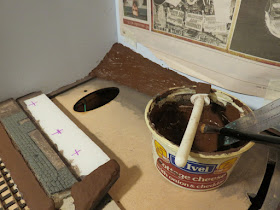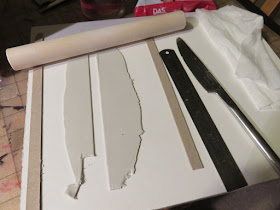The polystyrene land-forms have been covered with kitchen roll torn up and stuck in place with plenty of dilute PVA glue - this creates a strong shell.
The buildings have been trial fitted again, requiring some trimming of the edges of the clay to get a good snug fit, and their "levels" checked adjusting with card under the foundations to get thresholds at a sensible height to the street. Holes were drilled along the quay for the bollards, and I couldn't resist checking the fit of the sunken barge - now in primer - and an "old" boiler resin casting I'm thinking of using as a water tower. I've also primed and sprayed black the Langley etch of drains and manhole covers, and cut recesses into the clay where they are to be sited.
Along the terrace walls and steps have been made, though as yet no capping stones or railings, and the "pizza base" foam embossed with pathway paving. You can also see a fence trial-fitted along the front.
The next big job is to paint the cobbles, getting this right is important to the whole look of the area. I found some craft acrylic and started with a mid brown-grey colour, worked into all the cracks.
Next I added variations to the base colour - darker, more grey, and even a little redder - stippled onto the surface with a small sponge. This was quite effective, but looked a little blotchy, and perhaps too brown. In case you are wondering, the black "stripes" up the sky are to form shadows between the buildings, and the holes under them are in case I ever want to fit lighting. The quayside wall has had a coat of darker brown, and the capping stones a dark grey.
Once that was all dry I reverted to enamels. Two shades of grey were applied dabbing on with a piece of kitchen roll, aiming to give the tops of the cobbles a greyish finish.
Finally I finished with a very thinned brown wash allowing it to flow into all the crevices, and dabbing any excess off the surface - though it is too thin to cover the surfaces, only adding colour where it collects in the crevices. The quayside got a dark greenish-black wash too.
I'm happy that the result is quite close to what I was aiming for, these pictures of Tatton Park farm (which inspired my Landswood Park Farm layout) were useful reference.
...which has had a coat of brown filler. I mix powdered interior filler with various colours of powder paint before adding water to a thick paste, this is applied with spreader or cheap brush to cover the kitchen roll and polystyrene.
Next up, a number of details need painting and fitting, along with the buildings, in preparation for ballasting and greenery.


























